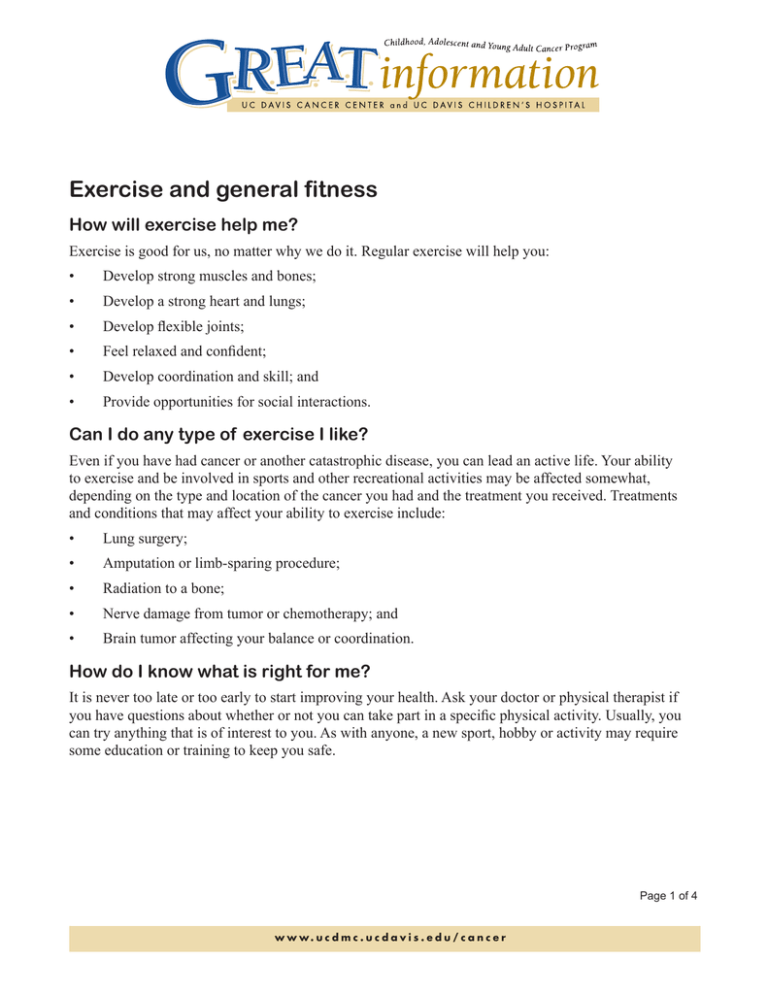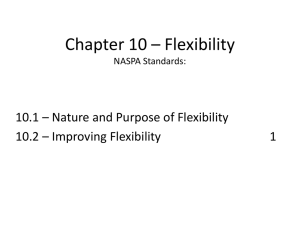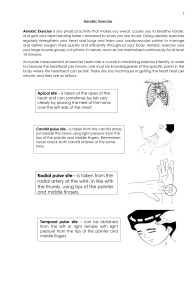Exercise and general fitness How will exercise help me?
advertisement

Exercise and general fitness How will exercise help me? Exercise is good for us, no matter why we do it. Regular exercise will help you: • Develop strong muscles and bones; • Develop a strong heart and lungs; • Develop flexible joints; • Feel relaxed and confident; • Develop coordination and skill; and • Provide opportunities for social interactions. Can I do any type of exercise I like? Even if you have had cancer or another catastrophic disease, you can lead an active life. Your ability to exercise and be involved in sports and other recreational activities may be affected somewhat, depending on the type and location of the cancer you had and the treatment you received. Treatments and conditions that may affect your ability to exercise include: • Lung surgery; • Amputation or limb-sparing procedure; • Radiation to a bone; • Nerve damage from tumor or chemotherapy; and • Brain tumor affecting your balance or coordination. How do I know what is right for me? It is never too late or too early to start improving your health. Ask your doctor or physical therapist if you have questions about whether or not you can take part in a specific physical activity. Usually, you can try anything that is of interest to you. As with anyone, a new sport, hobby or activity may require some education or training to keep you safe. Page 1 of 4 w w w. u c d m c . u c d a v i s . e d u / c a n c e r Continued Are some activities better for me than others? Exercise that strengthens your heart, lungs, muscles and bones are best for overall fitness. Some good examples are: • Swimming; • Brisk walking; • Biking; • Horseback riding; • Bowling; and • Tennis. Are there options for those of us with special needs? Yes! Specialized equipment exists to allow you to participate in most recreational activities. Your therapist can help you choose what you need. Items can be purchased that allow you to: • Fish using only one arm; • Golf from a wheelchair; • Swim despite any limitation; • Bowl regardless of function; • Grip a tennis racquet or pool cue, despite hand weakness; and • Lift weights from a wheelchair. Should children play sports? Exercise is just as important for children as anyone else, maybe more so! • Be sure your child has plenty of opportunities to play outside. • All children should be encouraged to participate in physical education at school, even if activities need to be modified for special needs. • As always, be aware of safety. Use the right equipment and protective gear. • Seek advice from your doctor before allowing your child to participate in a weight-lifting program or competitive sports. Page 2 of 4 w w w. u c d m c . u c d a v i s . e d u / c a n c e r Continued I’m not interested in sports, but I’d like to be stronger. What should I be aware of? Before you start an exercise program, set some reasonable goals. • Start out slow. Do not attempt activities that are too strenuous or put you at risk for muscle strain. • Be aware of your posture. Using correct posture during exercise can reduce injuries. • The saying “no pain, no gain” may lead to injury. Exercise until very tired, but not to the point of pain. How can I exercise safely? • Identify your goals and choose activities that will help you reach those goals. If you are working on strength, identify the muscles you want to strengthen and choose exercises that strengthen those muscles. • Begin at a safe level. If you have to strain to complete the exercise, it is probably too difficult. • Stop when fatigue occurs. • Balance exercises between different parts of the body. • Do your exercises with the right posture so that you will not strain your back. • Warm up muscles by stretching first. Finish your exercise program by stretching again. I think I need to work on cardiovascular fitness rather than strength. How do I do it? • Exercise is important for the circulation within your entire body. Proper circulation helps your body use its nutrients more effectively. • Warm up for 5 to 10 minutes, including stretching and slow, easy movements, gradually increasing your effort. • Increase the pace of the activity to a rate that you can hold for 20 to 30 minutes. • Cool down for 5 to 10 minutes with more stretching and slow, easy movements. • Do this three to five times per week. • To avoid injury, use the right equipment and shoes. Avoid running, jogging, or aerobic dancing on hard surfaces such as asphalt or concrete. • Increase your workout by no more than 10 percent each week. • If pain begins, heed the warning and slow down. Page 3 of 4 w w w. u c d m c . u c d a v i s . e d u / c a n c e r Continued What activities will help my bone density? Exercise is the most important factor for maintaining and developing new bone growth. Short-term, high-performance activities are best. Thirty minutes of exercise per day is best for building bone, but if you cannot find a 30-minute block of time, you can get the same bone benefit by dividing your exercise into three 10-minute sessions. Typical weight-bearing exercises include: • Brisk walking; • Jogging or sprinting; • Weightlifting; • Team sports; • Yoga; • Karate; • Jumping rope; • Aerobic dancing; • Tennis; • Racquetball; • Basketball; • Volleyball; and • Skiing. Questions? If you have questions about exercise and general fitness, ask your physical therapist or doctor. Adapted with permission from St. Jude Children’s Research Hospital. Revised 7/03 UC Davis Cancer Center 12/06 w w w. u c d m c . u c d a v i s . e d u / c a n c e r Page 4 of 4


